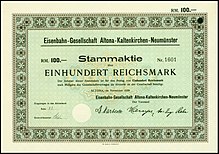Common stock
The term common stock (English voting share or common stock ) describes the property of a share to carry voting rights . The counterpart to a common share is the preferred share , which does not carry voting rights, but is given preferential treatment in some way to compensate for the lack of voting rights, for example through a higher dividend .
Together with the total of the nominal values of the preferred shares issued (issued) , the total of the nominal values of the ordinary shares issued forms the share capital .
Right to vote
Each common share represents a shareholder's right to vote at company general meetings. Each common share is assigned exactly one vote ; multiple voting rights are prohibited under the German Stock Corporation Act . The economics ministers of the federal states can permit exceptions to this, insofar as it is necessary to safeguard predominant macroeconomic interests.
While it is now easy to bundle voting rights through a shareholders' agreement or securities lending agreement, this was previously not permitted; then the Securities Act of 1937 stipulated that "... who used to exercise voting rights ... Shares of another, he has gained particular by granting or promise benefits for this purpose ... is punishable by a fine of up to 100,000 Reichsmarks." However, voting rights were pooled by the custodian banks and in some cases also abused. At the Annual General Meeting of Daimler-Benz AG in 1993 , for example, the custodian banks sided with Daimler with their custodian voting rights and voted against a distribution of retained earnings, because the motion was rejected with more than 99.7 percent of the votes.
See also
- Corporation
- Notification of voting rights
- share
- Stock Corporation Act
- No-par share
- Par value share
- Preferred stock
- Registered share
- Bearer share
Individual evidence
- ↑ Law on stock corporations and limited partnerships based on stocks (Stock Corporation Act) of January 30, 1937 (§ 300)
- ↑ Friedrich-Ebert-Stiftung, Das Depotstimmrecht der Banken , January 2001, p. 38 ff.
